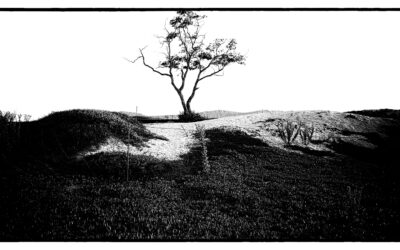The 6 Worst Mindsets a Creative Photographer Can Have Regarding Their Art and Business
Creativity and business might seem worlds apart for many photographers. After all, the pure artistic expression of photography is often thought to be free from the constraints of business.
But if you’re looking to sustain a career in photography, balancing both worlds is crucial.
While there are several positive mindsets that can propel your success, it’s equally important to be wary of the insidiously bad ones.
Here are the six worst mindsets a photographer can adopt regarding their art and business:
“My Work Speaks for Itself”
Sure it does, Bucky, but see, no one cares.
Why it’s detrimental: While confidence in your work is essential, this mindset assumes that just because you produce photos, clients will automatically come knocking. In reality, even the most talented photographers need to market themselves, network, and actively communicate the value they bring.
Shift to: “I’m proud of my work, and I’ll show it to anyone who has a pulse.”
“I Should Lower My Rates to Attract More Clients”
Yep, that’s a fast track to fry cook in a fast food chain owned by a clown.
Why it’s detrimental: Undercharging not only undervalues your skillset but also sets a precedent that can be tough to break out of. When you price too low, you might attract clients who don’t appreciate the true value of your work, leading to burnout and dissatisfaction.
You can’t make enough money to move ahead while slipping farther and farther into the swamp of the cheapass photographer abyss. And wait till you decide you have had enough and try to raise those stupid low rates. Your “clients” will run screaming away, calling you a rip-off con-man-girl-person.
(I know, I know… lose money on every sale but make it up in volume.)
Do you even hear yourself?
Shift to: “My rates reflect my quality, my professionalism, and my expertise. I bring it all to every job I do and I’ll focus on clients who understand and value that.”
“I Don’t Need to Learn Business; I’m an Artist”
Yes, I’ve been hearing that a lot from photographers who have lots of time to make art since they aren’t, you know, working.
Why it’s detrimental: Dismissing the importance of business knowledge means missing out on opportunities to grow and sustain your creative endeavor. You might be an amazing photographer, but without understanding finances, marketing, or client relations, your business might suffer. And you’ll end up in one of those forums on FB or Quora whining about how everybody else gets a break but you, and it is, oh my god, so unfair. I mean… I never!
Shift to: “I’m creative to my very core, but I’ll master the business side to fuel my passion.” You could add, “I’m not stupid…”, — no, don’t do that. Just whisper it a little when it’s dark.
“Every Opportunity is a Good Opportunity”
Sure it is. Remember Bitcoin, and that snazzy NFT thing you bought from that big-name Internet photographer for $10K that is now worth absolutely nothing? What a great opportunity that was. You can also sniff glue.
Why it’s detrimental: This is the ‘say yes to everything’ approach. While it’s tempting, especially when starting, not all opportunities align with your brand or long-term goals. Overcommitting can lead to exhaustion and might even detract from pursuing more fitting, lucrative ventures.
And in full disclosure, I recommend a starting photographer say yes to everything… everything that won’t hurt them, or another photographer, or have them taken advantage of. You still have to do your research, there’s no one-size-fits-all for anything. Except for steering wheel covers, I am told.
Shift to: “I’ll carefully evaluate every opportunity to ensure it aligns with my values, both personal and business.”
“Feedback and Criticism Are Personal Attacks”
Not usually, my thin-skinned weenie with slight narcissistic leanings. Most of the time, it is about the work.
Why it’s detrimental: Art is personal, and it’s natural to be protective of your work. However, seeing every piece of feedback or criticism as an attack can stifle your growth. It can make you weak, and steal your confidence. Constructive criticism is absolutely vital for improvement, and negative feedback can offer insights if viewed objectively. Without your penchant for everything being a personal attack, you may actually learn something valuable. Life-changing even. (It happened to me at a critique in San Francisco… I can still remember the moment.)
Shift to: “I welcome heartfelt and much-needed feedback as an avenue for growth and differentiation.” You don’t have to follow anyone’s guidance, but it is great when someone goes out of their way to try and help.
Evolving your mindset is just as crucial as honing your photographic skills.
By recognizing and addressing these detrimental mindsets, you’ll be better positioned to explore the intersection of art and business with resilience and success.

And now for the big-daddy of all bad mindsets for photographers:
“I charge by the hour, and materials, for the work I do.”
Awesome. If you are a good shooter, I’ll just hire you to come shoot jobs I bid on — I can keep what’s left over and make sure you get your hourly rate.
Why it’s detrimental: Because it doesn’t make sense in a value-driven business like photography and art, and misses the entire point of why we do what we do. We don’t sell a commodity like canned tuna, or those meat stick things hanging on the rack by the checkout stand looking kinda gross and greasy, and, damn, I hate those… Sorry. Got a little off track there.
We charge by the value of the gig. The needs and desires of the client give a photograph an intrinsic value. If we start viewing it as if it were simply a byproduct of our hourly effort and 32MB of storage space on a card, then we have lost the plot, Sherlock.
A photograph that will bring in a 4% increase in sales for a microchip company may equal millions and millions of dollars. That photograph is worth more than 3 hours, an SD card, and a basket of fish and chips for lunch.
Now, for sure, many photographers don’t think they are charging by the hour, but it is rare for me to be discussing their pricing and not have it come up in some sort of way. Day rate. Project rate. Per shot.
There’s nothing wrong with those as a framework, but ONLY as a framework. The value of the image must be calculated into the total somehow.
Of course, there are workaday shots like catalog stuff and cute kitty pattern oven mitts that must be shot on white for Amazon, but those are what they are. And yeah, maybe that shot of the cute oven mitt goes viral and the company sells 3.7 billion of them.
Then you are reminded once again about that great NFT of the photographer making coffee in an ‘awesome’ animated GIF that you spent 10 large on. And the irony will make you laugh.
And the world will be back to normal.

Finding Your USP: It May Be Simpler Than You Think
Let’s have a meeting of the minds about that elusive USP (Unique Selling Proposition) everyone keeps harping about.
You might be thinking, “Is it some magical formula, or a secret handshake I missed out on?”
Nope! Establishing your USP is straightforward, and you’ve got all the ingredients right there with you.
Let’s break it down, step by step, in the simplest way possible.
- Self-Awareness is Golden. Start by looking in the mirror. Not literally (though you’re looking good, by the way!). Understand what you genuinely love about your business, your passion, and what you excel at. Are you the fastest, the most detail-oriented, or perhaps the most innovative in your industry? Nail it down.
- Ask Your Tribe. Sometimes, we’re too close to see clearly. Ask your clients, colleagues, even friends: what’s the one thing they think you do best? Why do they choose you over someone else? Their answers might surprise you and provide that lightbulb moment.
- Scope Out the Landscape. Take a casual stroll through your industry (digitally speaking). What’s everyone else doing? Where’s the gap? This isn’t about copying, but about identifying a niche or an unmet need that you can address.
- Pain Points are Key. Dive into the problems your target audience faces. If you can solve a pain point that no one else is addressing or do it in a unique way, you’re onto something golden. Be the aspirin to their headache.
- Keep It Real. A USP isn’t about crafting a fancy slogan that sounds good on paper. It should be authentic, a true reflection of what you offer. If it isn’t genuine, trust me, people will sniff it out.
- Distill It Down. Once you’ve gathered all this information, simplify. Your USP should be concise, punchy, and straight to the point. Think of it as your elevator pitch – if you can’t explain it in a few seconds, it’s too complicated.
- Test and Tweak. Put your USP out there, and don’t be afraid to gather feedback. Sometimes, a little tweaking based on real-world responses can turn a good USP into a great one.
Your USP is like your business’s fingerprint – no one else has the exact same one.
And while finding it might require a bit of introspection and detective work, the result is a crystallized understanding of your unique value in the marketplace.
INTRODUCING: THE CREATIVE CLASS FREE EDITION
Are you ready to unleash your true potential?
Dive into The Creative Class and take a transformative journey into the world of creativity. In just a few sessions, we’ll challenge your perspective, sharpen your skills, and ignite that inner spark you’ve always felt.
It’s not just a class – it’s a vibrant community, an experience, a place where ideas flow freely and new visions come to life.
With 5 FREE classes waiting for you, there’s no better time to tap into that hidden talent, find your creative tribe, and truly make your mark.
Go on, take that bold step.

Unearthing Your Unique POV: A No-Nonsense Guide
Alright, pull up a chair, grab a cold one, and let’s hash this out.
We’ve all heard the chatter about the USP (Unique Selling Proposition), but there’s another way to go that’s equally, if not more, potent: the Unique Point of View (POV).
It really isn’t about what you’re selling, more about how you see the world.
Trust me, in an era where authenticity is more and more important, your unique POV may be your golden ticket.
I can hear you asking, “How on Earth do I figure out this POV magic?”
Fear not, intrepid creative person. We’ll break it down and find that unique lens through which only you view the world.
- Dig Deep Into Your Story. Every hero has an origin story, right? What’s yours? Your experiences, challenges, and personal narrative shape your perspective. Maybe you grew up in a multicultural city, or perhaps you switched careers three times. These experiences influence how you see and approach the world.
- Passions and Pet Peeves. What sets your heart on fire? And conversely, what grinds your gears? These strong emotions, whether love or frustration, can point towards a unique POV. If everyone’s zigging and it annoys you, perhaps your POV is all about zagging.
- Consume Widely, Reflect Deeply. Read books, watch movies, attend seminars – from outside your industry. Exposing yourself to varied stimuli can help refine your own viewpoint. As you consume, constantly ask yourself: “What do I think about this?”
- Engage in Conversations. Engage with people who think differently than you. Debates and discussions can clarify where you stand on specific topics. Sometimes, you find your unique POV by understanding what it is not.
- Write It Out. Heard of freewriting? Sit down, set a timer for 15 minutes, and write whatever comes to mind about your industry, passions, or experiences. No editing, no overthinking. This raw, unfiltered stream can be a goldmine for identifying your distinct POV.
- Your Values are Your Compass. What principles guide your life? Integrity, transparency, innovation? Often, your core values offer a clear lens into your POV. If sustainability is a key value, your unique POV might revolve around eco-conscious approaches in your industry.
- Seek Feedback, but Stay True. While it’s valuable to get external opinions, remember that your POV is inherently yours. Feedback can refine it, but don’t let it morph your perspective into a carbon copy of someone else’s.
The absolute bottom line:
Your unique POV is a blend of your experiences, values, and passions. It’s the specific angle from which you see the world, shaped by your journey. And while it might feel a bit daunting to zero in on, trust me, it’s there.
Keep looking and you will find it.
14 TRAITS OF THE MOST SUCCESSFUL PHOTOGRAPHERS: SELINA MAITREYA
14 TRAITS OF THE MOST SUCCESSFUL PHOTOGRAPHERS SELINA MAITREYA AND DON GIANNATTIWe had a wonderful meeting with Selina Maitreya today. She gave us her list of qualities that all of the successful photographers she knows posess. They Show Up and : / Are talented /...
USP VS POV: WHICH IS BETTER?
How to find your USP or UPOV. Over at my Substack, we discussed the divide forming between those advocating USPs and POV (I refer to them as UPOVs) In a nutshell: POV vs. USP: The Power Players in Branding Let's take a whirlwind tour through the buzzing world of...
DISCOVERING YOUR PHOTOGRAPHIC STYLE BY LOOKING BACK
Discovering Your Photographic Style by Looking Back at Your Favorite Work Everyone, from budding photographers to professionals, seeks a distinctive style that sets their work apart. But how do you discover that unique touch? One powerful method is to look back at...
The Business Case for Expanding Creative Skills
The Business Case for Expanding Creative Skills We have a small reprieve from the infernal heat in Arizona as Hurricane Hillary makes landfall just southwest of us. We are dry, but under the deep overcast, the temps are milder than usual. Imagine being happy that it...
5 THOUGHTS ON CREATIVITY
Unveiling the Mysteries of Creativity: A Field Guide Hey, you wonderful, marvelous creatives and visionary photographers! Let's get into the delightful world of creativity. It’s a complex, fascinating process that involves our whole brain. So, let’s uncover some...
15 PHOTO ASSIGNMENTS GUARANTEED TO BRING YOU PEACE
Whether with a camera phone or a big DSLR, these short assignments can bring you some well-earned peace. Just a snap for the shadows and light. You know how sometimes we get a little funky about not taking a photograph for way too long? Of course, that time can...






